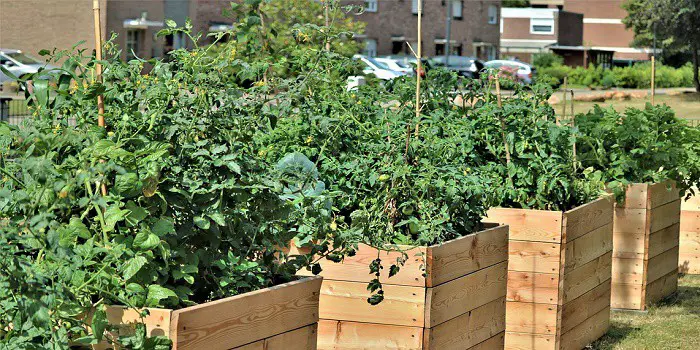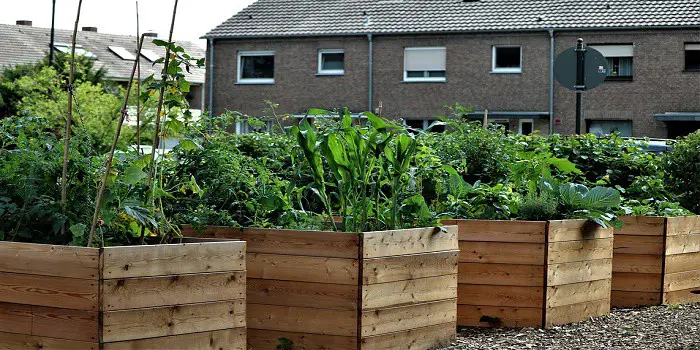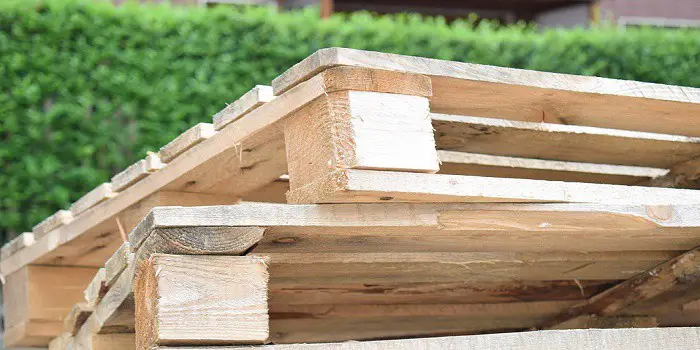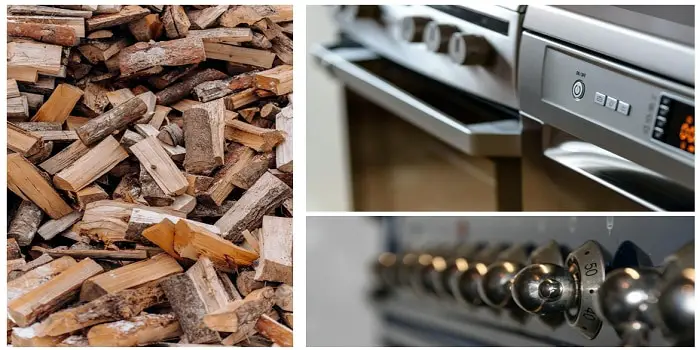
Gardeners prefer raised beds made of wood because they ensure a sound drainage system along with the perfectly leveled ground.
Plus, it’s easy to choose the type of soil you use to grow a specific variety of plants.
However, since the base of these raised frames will be resting on the ground, they can rot quickly.
One easy way to prevent the wood from rotting fast due to moisture, fungus, and insects is to use pressure-treated lumber instead of untreated wood.
Back in time, the biggest concern about using pressure-treated lumber was it was treated with chromium copper arsenate (CCA), which contained arsenic.
These were the toxic chemicals that can leach into the garden soil and can make the plants & vegetables unsafe for usage in the kitchen.
Thankfully, discovering this very issue, using wood with CCA treatment was prohibited by EPA at the end of 2003, much like common wood preservative creosote, which was also forbidden for residential use in the same year.
The Modern Pressure-Treated Wood is Safe
Presently, the pressure treated for residential use lumber undergoes treatment with borates and copper-based preservatives such as copper azole or alkaline copper quaternary (ACQ).
Since there is no arsenic content in these modern-day treated woods, these are considered safe for raised garden beds, including the crops and veggies grown for human consumption.
So, if you are considering using treated wood for constructing your raised garden beds – it’s essential to ensure that the wood you are using is NEW and is not treated with any highly toxic chemicals.
Using the type of wood that is highly durable and nontoxic will ensure that the edibles you grow in your garden are grown in chemical-free soil and are entirely safe for your family.
Tips When Using Treated Wood for Garden Beds
While there is a very low risk of chemicals getting into garden soil and plants – from pressure-treated lumber – if you still want to minimize or eliminate the effect, there are a few ways to do so.
Here are a few precautionary tips and steps you will need to follow when using treated lumber for raised beds…
1- Seal the lumber
Sealing the treated timber with good exterior-grade latex paint or a wood sealer like Thompson Waterseal can help in locking the chemicals into the wood itself.
This will prevent the soil from getting contaminated due to the preservatives present in the treated wood.
However, keep in mind that pressure-treated lumber can be difficult to seal compared to untreated wood.
Hence you may need to spend a good amount of time and energy on getting the job done.
2- Use a good plastic liner
Adding a layer of plastic liner – between the soil and wood frame – also reduces the chances of chemicals leaching into the soil and adulterating your edibles.
You can do this by laying down the plastic sheet inside the wooden bed frame just before you add the soil to it.
This will ensure that the chemicals from the wood are not taken up by the soil and the plants you will be consuming later.
3- Plant the edibles in the middle of the bed
The soil in the center part of the raised bed is not in direct contact with the wood.
Hence growing your crops far from the wood (i.e., in the middle of the raised bed) will lower the risk of getting lumber chemicals leaching into the plants.
The idea can be super helpful if you plan to grow edible and non-edible plants on the same raised bed.
Plant your edibles in the middle and non-edibles closer to the wood on the outer areas. This will help you use all the space in your garden.
What if you have old treated wood in your garden?
If you already have old treated wood as your raised beds, it’s better to get them replaced, especially for the sake of the consumables you need to grow.
However, if you are only growing ordinary plants other than edibles or veggies, you are OK with the treated wood.
Consider mulching your garden regularly, as it will help to prevent phosphorus deficiencies in the plants.
This is usually the condition when arsenic from the wood tends to move into the soil and plants.

Can You Make Treated Wood Waterproof for Raised Beds?
When using pressure-treated wood for raised beds, keep in mind that although the wood is resistant to insect infestations, it’s NOT WATERPROOF and can rot if exposed to continuous water supply or excess moisture.
However, that does not mean you cannot use it in your garden because you can still make the wood repel water by sealing the wood properly before installing it.
A few products that can be considered for waterproofing the treated wood include:
- Water-repellent stains and sealers
- Polyurethane, lacquer, or clear varnish
- Hand-rubbed finish of linseed or tung oil
For the best protection from water, I recommend applying alkyd-based stain-sealants to the treated wood first.
And then seal it with a glossy layer of water-based polyurethane or oil finish.
This will prevent the water from damaging the wood and can help your raised wooden beds last for a long time.
Alternatives to Treated Wood for Raised Vegetable Garden
If you are still uncomfortable with using treated wood near your plants and veggies, a few substitutes can be used for constructing raised beds.
Some of these include:
a) Natural wood
Redwood, cypress, cedar, and certain oak varieties can naturally resist decaying.
But these can be expensive to purchase, and the supplies can be limited depending on your region.
When buying natural wood from the dealer, check whether its wood is heartwood or sapwood.
Heartwood from the same tree will usually last much longer than sapwood.
b) Untreated lumber
Untreated timber is readily available and is a cheaper alternative to pressure-treated lumber for raised beds. Plus, it’s also plant-friendly.
The only drawback is it’s prone to get damaged by insects and fungi. So, if that’s the problem in your garden, you should better avoid it.
c) Synthetic or composite lumber
Recycled plastic or composite wood is made from various types of consumer waste meant to be used in landfills.
It’s a great alternative to treated wood available in the market with different brand names, like Trex. You can check with the supplier in your area to find out if they provide this composite lumber as a raised-bed kit.
In addition to all the above alternatives, you can consider building raised beds in your garden with natural stones, bricks, or concrete blocks.
However, I am not pretty sure how safe it would be to use these materials for edible plants, vegetables, and crops.
Final Thoughts
Pressure-treated wood repels various garden bugs and can last longer than untreated wood. And that’s the reason these are mostly preferred for constructing raised beds.
By using highly durable treated wood, you can also save the environment, as it will mean that only fewer trees would be cut in the long run.
You only need to remember to opt for the new treated wood variety that is not chemically harmful to your plants and garden.
By doing so, you will be automatically keeping your family safe and healthy.
Share the post "Is Pressure Treated Wood Safe to Use for Raised Garden Beds?"

Hi, I am Mark Garner a professional carpenter, woodworker, and DIY painter. I live in the small city of Peoria, Arizona as a semi-retired woodworker. I have started this blog with a simple motive to help you with my wood experience in this sector. If you like to know more about what I love doing and how it all got started, you can check more about me here.




